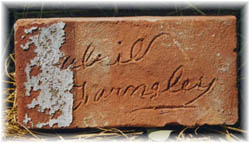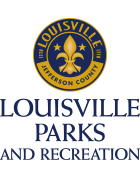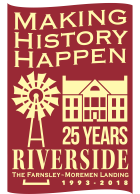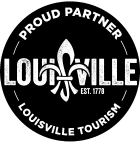Gabriel Farnsley
In 1849, the property known as Riverside today, was described as follows: “a certain tract of land in Jefferson County about 14 and a half miles below Louisville fronting the Ohio River, containing 200 acres, having upon it an excellent brick house, and other good improvements. Also, an excellent apple orchard of about 300 bearing trees of the most choice quality of fruit for the lower market.”
The person responsible for creating this establishment was Gabriel Farnsley. Farnsley was born on March 15, 1800 in Louisville, Kentucky. Farnsley purchased the 200-acre tract on the river in 1826 with business partner Ebenezer Williams. In 1828, Farnsley bought out Williams’s share in the property and became the sole owner.
 Farnsley probably completed the “excellent brick house” at Riverside circa 1837. Regardless of the exact date of completion, Farnsley left clear evidence that he was responsible for the construction of the house. He etched his name in the wet clay of one of the bricks before it was baked in the kiln. The brick bearing his signature was found in the cornice of the house during its restoration.
Farnsley probably completed the “excellent brick house” at Riverside circa 1837. Regardless of the exact date of completion, Farnsley left clear evidence that he was responsible for the construction of the house. He etched his name in the wet clay of one of the bricks before it was baked in the kiln. The brick bearing his signature was found in the cornice of the house during its restoration.
Unlike Gabriel Farnsley, the slaves who very likely actually molded, fired and laid the bricks of this imposing house did not leave behind such clear information about their identities or the roles they played in the building of the house and farm. At the time of Farnsley’s death in 1849, he owned thirteen enslaved African Americans.
On February 25, 1850, these thirteen individuals were sold at public auction on the steps of the courthouse in Louisville along with all of Farnsley’s other “property.”
The Decree of Sale names each individual and lists their ages: “Tom about 55, Peter 19, Henry 13, Jim 7, Anna 40, Eliza 21, Emily 17,Milly 10, Mary Ann 8, Martha [illegible] years old, Josephine 18, and Mary Ann (child of Emily) about 8 months old.”
These thirteen individuals, likely representing a couple of families, were sold to eight different new masters. You can learn more about the African Americans at Riverside on our website, as well.
The striking façade of Gabriel Farnsley’s home must have attracted the attention of the many travelers moving by steamer, keelboat or flatboat on the 19th century superhighway called the Ohio River. No doubt a good number of these voyagers stopped at Farnsley’s landing to take on boilerwood, to trade for some of the goods or food produced at his farm or even to spend the night.
Based on a partial inventory and settlement of Farnsley’s estate in 1849, we know Farnsley’s agricultural operation involved the cultivation of fruit trees, hay, oats, wheat and corn. He raised hogs and cattle and he kept bees. He also sold timber from his wooded land to passing steamboats for fuel.
Gabriel Farnsley died in 1849, perhaps suddenly, as he left no will. Farnsley had also remained a bachelor his entire life. These factors complicated the settlement of his estate. Several court cases involving 21 parties–primarily Farnsley’s surviving siblings and nieces and nephews–played out over the next dozen years. The documents from these long-running court cases are still being studied. They promise to reveal more about Gabriel Farnsley’s life, his farming operation, and the lives of the enslaved the African Americans he owned.





